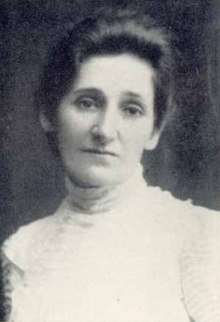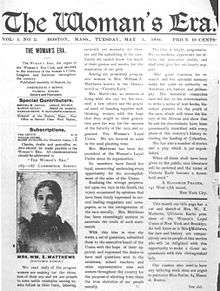Victoria Earle Matthews
Victoria Earle Matthews (née Ella Victoria Smith, May 27, 1861 – March 10, 1907) was an American author, essayist, newspaperwoman, settlement worker, and activist.[1] She was born into slavery in Fort Valley, Georgia and moved New York City with her family after emancipation. There, she briefly attended school and worked as a domestic servant to help her family.
Victoria Earle Matthews | |
|---|---|
 | |
| Born | Ella Victoria Smith May 27, 1861 Fort Valley, Georgia, U.S. |
| Died | March 10, 1907 (aged 45) New York City, U.S. |
| Nationality | United States |
| Occupation | Writer, activist |
As a married woman, Matthews became involved in women's clubs and social work, at a time when the settlement movement started in Great Britain in 1884 was influencing American social work in major cities. In 1897, Matthews founded the White Rose Industrial Home for Working Class Negro Girls, also known as the White Rose Mission, a settlement house for young Black Women, to provide them with safe housing, education, and life and job skills.
Early life and education
Victoria Earle was born into slavery in 1861 in Fort Valley, Georgia[2], a month before the start of the Civil War. Shortly after she was born, her mother, Caroline Smith, escaped from their master, leaving behind Victoria and her eight siblings.[3] The Smith family’s racial ambiguity, and the fact that the children lived in the master's house, conforms to the belief that their owner was their father.[3] When her mother reached New York, she planned to earn enough money to purchase her freedom and that of her children. In 1869,Caroline Smith "reportedly was forced to wage a legal battle to regain custody of her two daughters"[3] and she was first black woman to be recognized in Georgia's court system. Matthews, her mother, and her sister, Anna, traveled from Georgia to Richmond and Norfolk, Virginia, and eventually, ended up in New York City in 1873.[3]
In New York, Matthews attended public school for only four years, until family difficulties forced Matthews to withdraw from public school and work as a domestic servant,[3] where she took advantage of her employer’s full home library. The owner discovered Earle reading and gave her permission to do so when she had time. In order to read and learn, Earle worked harder to finish tasks early. Brown (1988) describes the young Victoria Earle as “gentle, respectful to elders, affectionate and most helpful to all who seemed to need her services.” (p. 208).
Marriage and family
In New York City, On October 22, 1879,[4] at the age of eighteen, Victoria Smith married William E. Matthews, a coachman from Petersburg, Virginia.[5] They had one son, Lamartine, who died on September 19, 1895 [6]at the age of sixteen.
Journalism
Matthews started writing and working to establish a career as a journalist and fiction writer. Simultaneously, she became increasingly interested in politics and issues affecting blacks, such as lynchings and barriers to education. She focused on promoting a consciousness of the Black struggle, specifically Black Women. She wrote short stories, such as "Aunt Lindy," "Eugenie's Mistake: A Story," and “Zelika—A Story." All of these works feature benevolent, black, female protagonists that represent the conflicts of colorism and learn to develop dignity in their blackness.[7] "Aunt Lindy" told of forgiveness and reconciliation during the Post-Civil War years. She also produced a stage play that explored the idea of miscegenation.[8]
Political activism

In the early 1890s, Matthews became more involved in the African-American political and social circles. On October 5, 1892, Victoria Earle Matthews and educator and activist, Maritcha Remond Lyons, organized a testimonial dinner in New York’s Lyric Hall for Ida B. Wells and her anti-lynching campaign which led to the founding of the Woman’s Loyal Union of New York and Brooklyn.[9][10] It was a time of the rise of fraternal and women's organizations, and Matthews served as the first president of the Woman's Loyal Union (WLU) and .[11] The WLU was a civil rights organization that worked against racial discrimination and supported the anti-lynching crusade of the journalist Ida B. Wells . Matthews served as the Chairman of the Executive Board in 1896 of the National Association of Colored Women.[2] She frequently spoke on the issues of the times. Matthews was best known for her speeches “The Value of Race Literature," “The Role of Afro-American Women,”[8] and "The Awakening of the Afro-American Woman" (1897)[12]. "The Value of Race Literature was delivered at the First National Congress of Colored Women in Boston, Massachusetts on July 30th, 1895.[13] Her speeches were rooted in the philosophy of race pride and self-worth.
After the death of her 16-year-old son, Lamartine, Matthews channeled her grief and began to concentrate on helping young people of his age.[2] She returned to the South, having read about the continuing need for education for blacks. In the state of Alabama, she began looking into what was being done for people of color. Eventually she became involved in settlement work, started by Progressive women in industrial cities such as Chicago and New York, which were accepting tens of thousands of European immigrants, as well as many migrants from the rural South. A minister persuaded her to return to New York.
Matthews began to visit individuals and families where the need seemed great. She went from house to house providing practical services, such as helping an over-burdened mother prepare a meal, or do laundry.[2] Kramer (2006) quoted her as saying, “you cannot do anything with these people unless you talk plainly to them and are practical.” (p. 249). Matthews learned that life for African Americans was difficult and plagued with “limited economic opportunities, inadequate housing, poverty, prejudice, and racially motivated violence.”[14]
At this time, thousands of young blacks were arriving in New York as part of the Great Migration, in hopes of finding better work and opportunities than in the Jim Crow South. Matthews thought that young women needed a safe place to stay while they learned job skills to allow them to work.[8]
Of mixed race, she had considerable European heritage; her fair skin and appearance, combined with her education, this enabled her to gain preferential treatment. She investigated business practices among both whites and blacks during this time period.[8] With the initial help of Winthrop Phelps, a white philanthropist who offered a flat in an apartment house he owned, on February 11, 1897, they opened a place where colored girls could go for training in domestic work. Matthews arranged for them to learn to sew, to make dresses and to prepare for service in society.[2]
According to Kramer (2006), Matthews also “envisioned daily kindergarten and manual training for boys with lectures in regard to domestic services” (p. 248). Matthews valued education and made it part of the programs she offered. Kramer (2006) wrote the “White Rose Mission stressed the training of African American girls in the principles of practical self-help and right-living.” (p. 248). In addition to life skills in math, reading and writing, Matthews educated her students in race history and literature. She maintained a collection of books on black history that was an available resource to all.[8]
Realizing that young women were at risk when they arrived in the city, Matthews and her supporters decided to set up a place that would offer housing, as well as to have volunteers meet new migrants at train stations, to offer their safe housing. They purchased a house on 217 East 86th street, which was called the White Rose Home for Working Class Negro Girls, or the White Rose Mission. Matthews encouraged the girls to live with purity, goodness and virtue.[2] To support the mission, she gained the support of prominent black ministers and major congregations, such as Adam Clayton Powell, Sr., pastor of the Abyssinian Baptist Church, who became a trustee of the mission.[15]
Matthews took pride in her race; she also sought to inspire individuals by equipping them with practical skills. She believed that with self-sufficiency, they could have noble thoughts, and great ideas.[2] Matthews and her volunteers taught young women the skills needed at the time: sewing, millinery, and cooking.[2] The young women had the chance to get decent, if low paid work. The White Rose Industrial Home allowed for students to be around their teachers, learning from them and each other in daily life, as well as to have some protection for a time. The White Rose Home also provided specific education and a range of social activities. Lerner (1974) explained how the mission offered recreation, literary and cultural events, and classes on Negro history. Settlement houses such as Matthews', and those founded by other women for immigrants in Chicago and New York, influenced the later development of YMCAs and summer camps as well.[11]
Works
Tribute
The all-black Victoria Earle Matthews (Mothers) Club, named after her, helped girls and women who had been sexually abused or threatened with such.[19]
Notes
- "G. F. Richings. Evidences of Progress among Colored People".
- Brown, 1988
- Hicks, Cheryl D. (2010-12-13). Talk with You Like a Woman: African American Women, Justice, and Reform in New York, 1890-1935. University of North Carolina Press. doi:10.5149/9780807882320_hicks.7. ISBN 978-0-8078-3424-4.
- Marriage License no. 156232 for New York County, Municipal Archives of the City of New York, 32 Chambers street, New York City
- Logan, Shirley W. (1999). We are coming : the persuasive discourse of nineteenth-century Black women. Southern Illinois University Press. ISBN 0-8093-2192-0. OCLC 39633753.
- "Race Gleanings," Indianapolis Freeman October 10, 1895
- Kerstin Rudolph (2016). "Victoria Earle Matthews's Short Stories". Legacy. 33 (1): 157. doi:10.5250/legacy.33.1.0157. ISSN 0748-4321.
- Kramer, 2006
- Peterson, Carla (2011). Black Gotham: A Family History of African Americans in Nineteenth-Century New York City. New Haven: Yale University Press. pp. 354–355. ISBN 978-0-300-16255-4.
- Terborg-Penn, Rosalyn (1998). African American Women in the struggle for the vote 1850-1920. Indiana University Press. p. 87. ISBN 9780253333780.
- Lerner, 1974
- Logan, Shirley W. (1998). With pen and voice : a critical anthology of nineteenth-century African-American women. Southern Illinois Univ. Press. ISBN 0-8093-1875-X. OCLC 642917533.
- Robinson, Fred Miller; Matthews, Victoria Earle (1986). "The Value of Race Literature: An Address". The Massachusetts Review. 27 (2): 169–191. ISSN 0025-4878. JSTOR 25089736.
- Kramer, 2006, p. 246
- Mather, Frank Lincoln. Who's Who of the Colored Race: A General Biographical Dictionary of Men and Women of African Descent, Vol. 1, Chicago: Memento Edition, 1915, p. 222
- Matthews, Victoria Earle. "The Online Archive of Nineteenth-Century U.S. Women's Writings". Aunt Lindy: A Story Founded on Real Life. Retrieved 26 February 2012.
- Victoria Earle [Matthews] (2016). "Eugenie's Mistake: A Story". Legacy. 33 (1): 162. doi:10.5250/legacy.33.1.0162. ISSN 0748-4321.
- Victoria Earle [Matthews] (2016). "Zelika—A Story". Legacy. 33 (1): 176. doi:10.5250/legacy.33.1.0176. ISSN 0748-4321.
- "Overton, Sarah Massey (1850-1914) | The Black Past: Remembered and Reclaimed". The Black Past. 1914-08-24. Retrieved 2015-10-24.
References
- Brown, Hallie Q. (1988). "Victoria Earle Matthews" Homespun Heroines and Other Women of Distinction. New York, NY: Oxford University Press, Inc.
- Kramer, Steve (2006). "Uplifting our “downtrodden sisterhood”: Victoria Earle Matthews and New York City’s White Rose Mission, 1897-1907", Journal of African American History, 91(3), 243–266.
- Lerner, Gerda (1974). "Early community work of black club women", Journal of Negro History, 59(2), 158–167.
- Luker, Ralph E. (1984). "Missions, institutional churches, and settlement houses: The Black experience, 1885-1910", Journal of Negro History, 69(3/4), 101–113.
- Wade-Gayles, Gloria (1981). "Black women journalist in the South, 1880-1905: An approach to the study of Black women’s history", Callaloo, 11/13, 138–152.